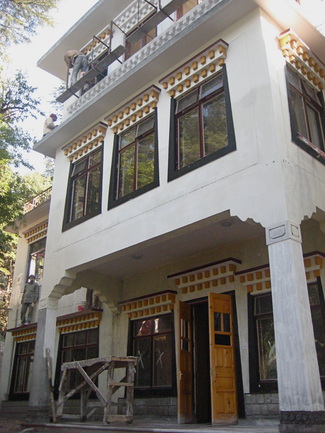Tibetan Buddhist Temples
A beautiful new meditation hall in the Indian Himalayas
A trip to India seems difficult to do for some people; imagine trying to construct a two story building there with absolutely no experience, no money, huge language and cultural barriers and a team of diverse foreign volunteers all trying to give you their opinions, sometimes at the same time!
Somehow, with an efficient architect in Malaysia, a fantastic fund raising team in Singapore, faith in my precious Lama who knew that I would somehow manage to do it, a beautiful Tibetan 3rd Temple was born to grace the mountain at Tushita Meditation Centre in Dharamsala.

For the last 5 years, I was the director of Tushita Meditation Centre, located in the forested hills of Northern India – the seat-in-exile of His Holiness the Dalai Lama and home to the main Tibetan community in exile.
It was there that I found myself somehow involved in an insane and seemingly impossible project to build a two story building in India...how did I get here?!
Fifteen years ago my teacher, Lama Zopa Rinpoche requested that the Tushita meditation hall be rebuilt. The old colonial building was constructed more than eighty monsoons ago; its mud, straw and stone walls were crumbling and the ceiling was letting in rain, stones and the occasional monkey. The hall needed to be enlarged and the ceiling raised: the twelve-foot high Buddhist statue's head was almost shooting through the roof!
I knew absolutely nothing about building, architects or Indian or Tibetan workers and didn't have a cent but i was determined to get this done as the old building was becoming very dangerous. I knew a good challenge when I saw one! I had no idea how insane and difficult it would be.
Rinpoche requested that the new Gompa, as it is called in the Tibetan language, be made in the Tibetan style. Absolutely loving Tibetan Buddhist Temples, I enthusiastically agreed!

Woman builder from India.
After years of stop-start, the massive job of rebuilding began in March of 2007. The building was first torn apart carefully around Lama Yeshe’s room as we had originally wanted to preserve it. But as the walls became visible we could see clearly that it was not possible. Perhaps in a Western country there might have been a way to preserve it but not here in the Himalayan foothills where women, instead of bulldozers, carry away the dirt – on their heads; where cows sleep in the street and where the local bank has only just discovered the internet.
When we first discussed the possibility of preserving the room, the Indian engineer and the Tibetan contractor said that it would be no problem! In retrospect, I think they had no idea what on earth I was talking about, or they were not taking this strange foreigner seriously. This was the first of a long series of misunderstandings. Sadly we had to tear the room down in the end.

We needed to begin excavating the foundation before the three-month monsoon began, or the holes would be flooded and all work would have to stop. We still didn’t have permission to begin. How long it would take to receive this permission was never quite clear. One day I was told that it would take only three months, the next day, six. It seemed that the people who gave permission only met once every few months, and the exact time of the meeting, like almost everything else, seemed to be some abstract entity that evolved minute by minute. The engineer would say one thing, and then if asked the exact same question five minutes later would give a different answer without even being aware of it. Same with the contractor. Whenever I got them together and called them on the answers I had been given, they would both deny it furiously!
Sometimes the contractor would stick huge wads of tobacco in his mouth just before I’d come up to talk to him, possibly so I wouldn’t understand a word. So between this and the lack of English, communication is always a chore.
During my two-year-long adventure to find a decent architect, I designed and re-designed it at least thirty times. I finally found a wonderful architect in Malaysia, a kind and dedicated student of my teacher's, who had already done several projects for him. After working feverishly with him for more than a week, I went to Singapore to see a friend who had worked previously on the design with me. I pulled out the designs in a fit of excitement because, after two long years, it was finally done! My friend said the plans needed to be reworked. I tried to explain that, no, I’m terribly sorry, but these were the final plans and could not under any circumstances be changed – then spent the next three hours re-designing yet again. But hear this: the final, final version is great, and woe betide anyone who tried to give me any more advice on the structure when I returned home to Tushita!

We began construction before actually receiving the permission needed to build. The Indian engineer was saying, “Don’t worry, it’s as good as got!” Well, this worried me a great deal. He says that he “knows someone,” which translates to: if I give him enough money or in one case, a bottle of whiskey and a live chicken, he will be my friend and give me what I want. “Baksheesh” is commonly used to grease the wheels of bureaucracy. They say that it speeds things along, but I really think that it’s actually the only way that anything gets done at all in India. Sometimes you even get a receipt! So, just to be sure, I had him sign a paper saying that he would take full responsibility if anything went wrong. Thank goodness we never had to test this theory.
Excavation of the foundation began quickly. We beat the monsoon, and the meditation hall began shooting up rapidly. But apparently this is the contractor’s biggest job of his career so far, and thus he made a huge miscalculation about how long it would take to build the new hall. Originally he said it would take two years. Suddenly and miraculously it has been cut down to only one year. This, too, makes me very nervous. When I enquired about the reasons for this, the answers were varied and interesting. The one I like best is that “the workers so happy then so much quick doing!” Hmm... The contractor couldn’t understand why I was not as delighted as he was, especially when he starting asking for more than double the monthly installments he and I had worked out originally. Having more than a year to come up with the rest of the money is quite different from having to pay the whole thing off by next Spring. Stressful?
One thing that took some getting used to is the fact that toddlers accompany their parents to the working site. Some of the kids, barely able to walk, are following their mothers around the site, past deep ditches and through piles of wood with rusty nails. It’s hard to watch, but it seems to be a completely acceptable situation in Indian society, so I quickly gave up my initial protests.
This stressful yet adventurous story ended happily. The new meditation hall was finished successfully and my teacher, upon inspection said that it was just 'perfect' and that made me smile.
I have many more pictures of Tibetan Buddhist Temples, Asian Temples, Chinese Temples and especially this one, my hand made temple. I will one day publish many more if I get time.
Thank-you for reading my little story.

Return from Tibetan Buddhist Temples to Tibetan Life Homepage
Yoga |
Translation |
Gifts |
Buddhism |
Dalai Lama |
Food |
Symbols

















